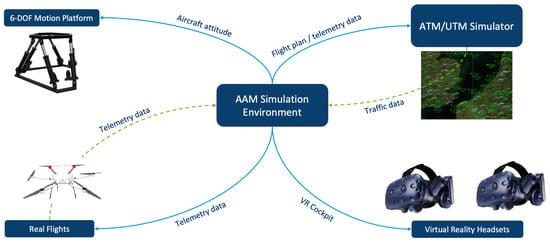An Advanced Simulation for Implementation of Advanced Air Mobility
Working together, scientists from three countries plan a future for Advanced Air Mobility

Working together to hasten the safe introduction and integration of Advanced Air Mobility (AAM) into the national airspaces of countries around the globe, a group of researchers from Cranfield University, Boeing Research and Technology—Europe, ANRA Technologies, Airbus-Unmanned Traffic Management, Royal Netherlands Aerospace Centre, Ineco, and NTT Data, published an article, “The Development of an Advanced Air Mobility Flight Testing and Simulation Infrastructure.” The article proposes an infrastructure that encompasses future use cases, ranging from air taxi operations to cargo delivery – the whole of U-space services – enabling them to operate harmoniously with each other.
A layered approach
The team aims to devise a new airspace structure using different layers for standard-performing vehicles (SPVs), high-performing vehicles (HPVs), and new services to facilitate this structure. They also propose to build a holistic contingency management concept that results in a safe, efficient air traffic environment. This U-space envisions a complex traffic environment that necessitates coordination between operators, U-space service providers (USSPs), and the air traffic controllers overseeing these operations.
The study aimed to provide a testing baseline for each element of AAM and how best to integrate them into a cohesive real-world environment. To do this, the proposed infrastructure consisted of three main elements: the co-simulation environment, actual platforms, and the AAM simulator.
From preflight to flight to safe landing
To closely approximate a common, everyday scenario, the study used a Swift VTOL UAV and Cranfield Multicopter. The whole air taxi passenger experience was considered and the components required to deliver that experience, such as flight plan updates, collaborative interfaces, and AAM simulators were tested and the outputs deployed in a variety of scenarios and flight plan definitions.
Planning for the unplanned
The resulting simulation infrastructure allowed the researchers to test varying use cases to produce finalized flight plans, including detailed trajectories at every phase of the flight. Consequently, a scenario that could predict departure times and allowed for the risks and capacities being proposed could be realized.
The system demonstrated how air traffic could be monitored and what steps might be taken should there be a disruption during in-flight services. Their communications included real-time data, simulated vehicles, and an AAM simulator with a virtual reality (VR) feature.
Test, validate, implement
As the research continues, the scientists plan to validate their AAM concept in their project’s next phase via a live demonstration that will include stakeholders who have elected to participate. The team then plans to analyze the technical aspects and data, which will then enable them to make recommendations to help AAM realize its full potential.
Want to learn more about the emerging urban/advanced air mobility markets? Visit us at AeroCar Journal and subscribe today. It’s free (for a limited time!).
#aerocarjournal #aam #aerocarjournal #evtols #uas #utm #u-space #onlyatcranfield


